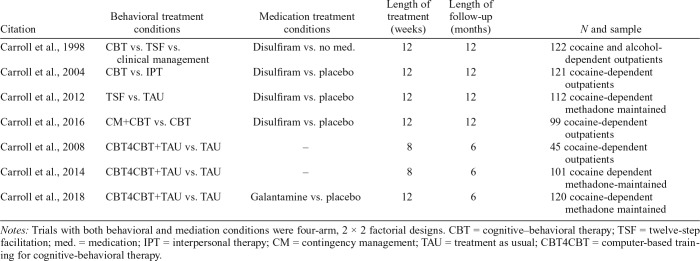Table 1.
Overview of studies in pooled dataset
| Citation | Behavioral treatment conditions | Medication treatment conditions | Length of treatment (weeks) | Length of follow-up (months) | N and sample |
| Carroll et al., 1998 | CBT vs. TSF vs. clinical management | Disulfiram vs. no med. | 12 | 12 | 122 cocaine and alcohol-dependent outpatients |
| Carroll et al., 2004 | CBT vs. IPT | Disulfiram vs. placebo | 12 | 12 | 121 cocaine-dependent outpatients |
| Carroll et al., 2012 | TSF vs. TAU | Disulfiram vs. placebo | 12 | 12 | 112 cocaine-dependent methadone maintained |
| Carroll et al., 2016 | CM+CBT vs. CBT | Disulfiram vs. placebo | 12 | 12 | 99 cocaine-dependent outpatients |
| Carroll et al., 2008 | CBT4CBT+TAU vs. TAU | – | 8 | 6 | 45 cocaine-dependent outpatients |
| Carroll et al., 2014 | CBT4CBT+TAU vs. TAU | – | 8 | 6 | 101 cocaine dependent methadone-maintained |
| Carroll et al., 2018 | CBT4CBT+TAU vs. TAU | Galantamine vs. placebo | 12 | 6 | 120 cocaine-dependent methadone maintained |
Notes: Trials with both behavioral and mediation conditions were four-arm, 2 × 2 factorial designs. CBT = cognitive–behavioral therapy; TSF = twelve-step facilitation; med. = medication; IPT = interpersonal therapy; CM = contingency management; TAU = treatment as usual; CBT4CBT = computer-based training for cognitive-behavioral therapy.

